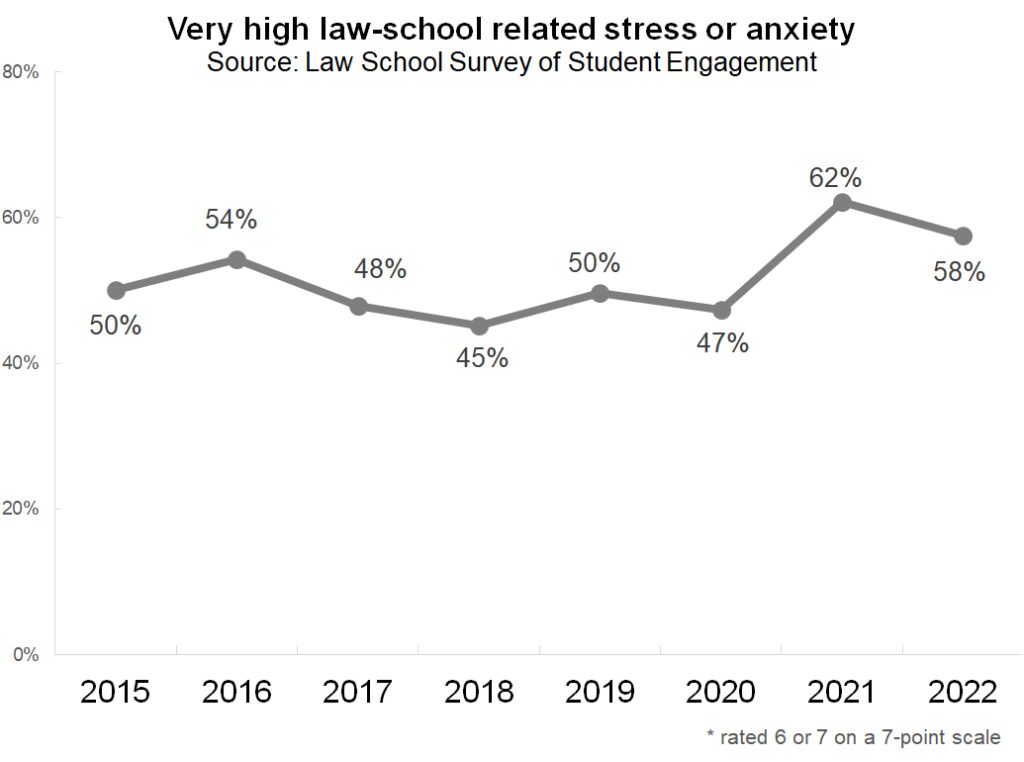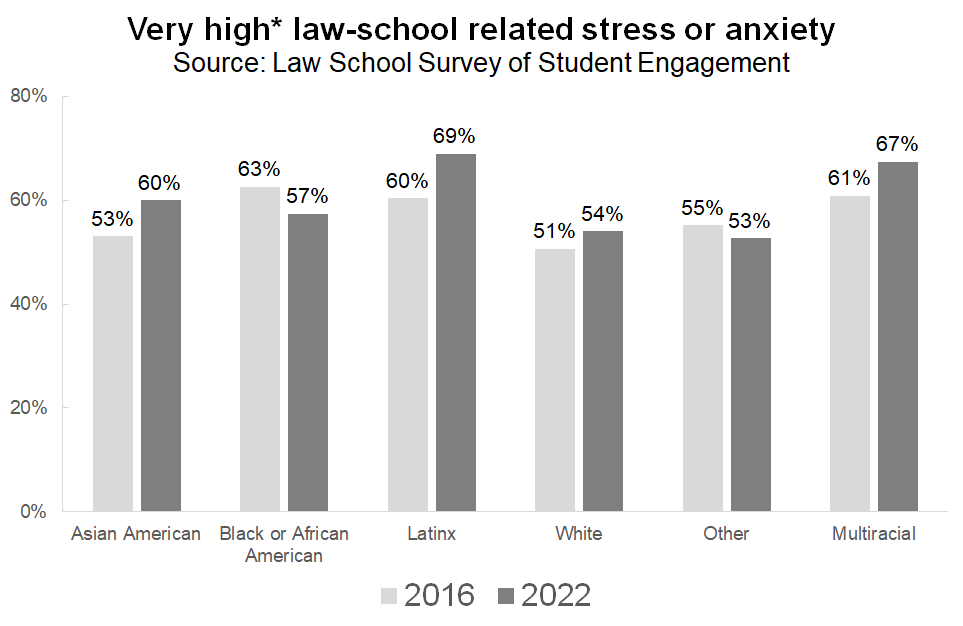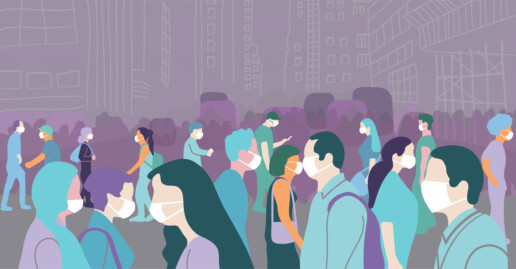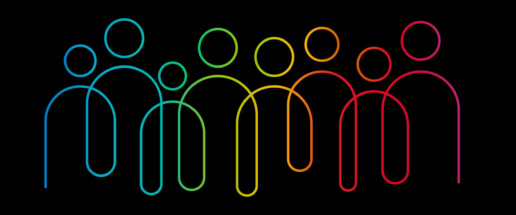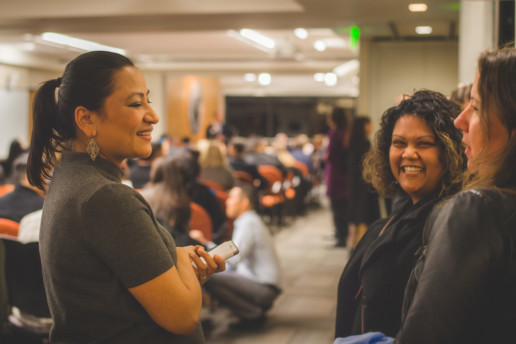Dispelling the Asian American Monolith Myth in U.S. Law Schools
Dispelling the Asian American Monolith Myth in U.S. Law Schools
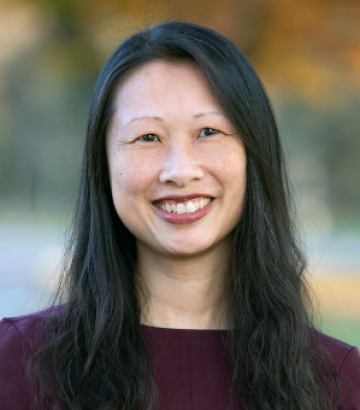
Katrina Lee
Clinical Professor of Law, and Director of Program on Dispute Resolution
The Ohio State University, Moritz College of Law
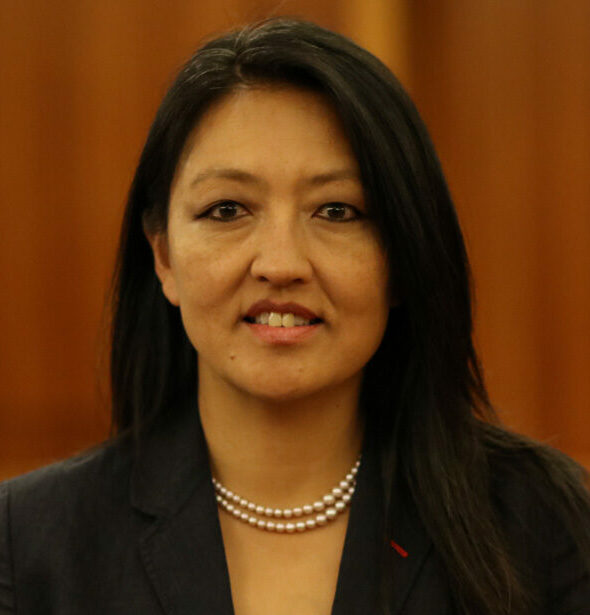
Rosa Kim
Professor of Legal Writing
Suffolk University Law School
In the past year, following an exponential rise in anti-Asian violence and discrimination in the U.S., we wrote an essay about inclusion of Asian American faculty in legal academia. We discussed harmful stereotypes and myths about Asian Americans. We called on the legal academy to do more to acknowledge and address the challenges faced by Asian American faculty and to amplify their voices, work, and presence.
Law schools must also do the same for Asian American students in U.S. law schools.
Asian Americans have often been viewed and treated as a single homogenous group. And yet the story of Asians in America is one of rich diversity. Today more than 20 million people who identify as Asian American live in the U.S.[1] The term Asian American encompasses at least 21 distinct groups.[2] In 2019, people who identify as Chinese, Indian, Filipino, Vietnamese, Korean, and Japanese accounted for 85% of Asian Americans.[3]
Asian Americans are diverse economically. The disparities in income across Asian American households are among the widest in the country. While Asian American households in the U.S. had a median annual income of $85,800 in 2019—higher than the $61,800 among all U.S. households—most groups of Asian Americans report household incomes well below the national median for Asian Americans.[4] For instance, Burmese American households have a median income of $44,400.[5]
Unsurprisingly, Asian American law students[6] are diverse. LSSSE survey data about Asian American students dispels the monolith myth and reveals the need for law schools to act to provide support for all Asian American students. LSSSE’s recent report of Asian American law students is aptly named Diversity within Diversity: The Varied Experiences of Asian and Asian American Law Students.
Within the group of Asian American law students surveyed, 81% of respondents comprised six ethnic groups: Chinese, Korean, Indian, Filipino, Japanese, and Vietnamese.
International students of Asian descent are a growing cohort in U.S. law schools. By far, Chinese respondents were more likely than any other group to be international students; 50% percent of them identified as international students, while just 1% of Filipino respondents identified as international students.
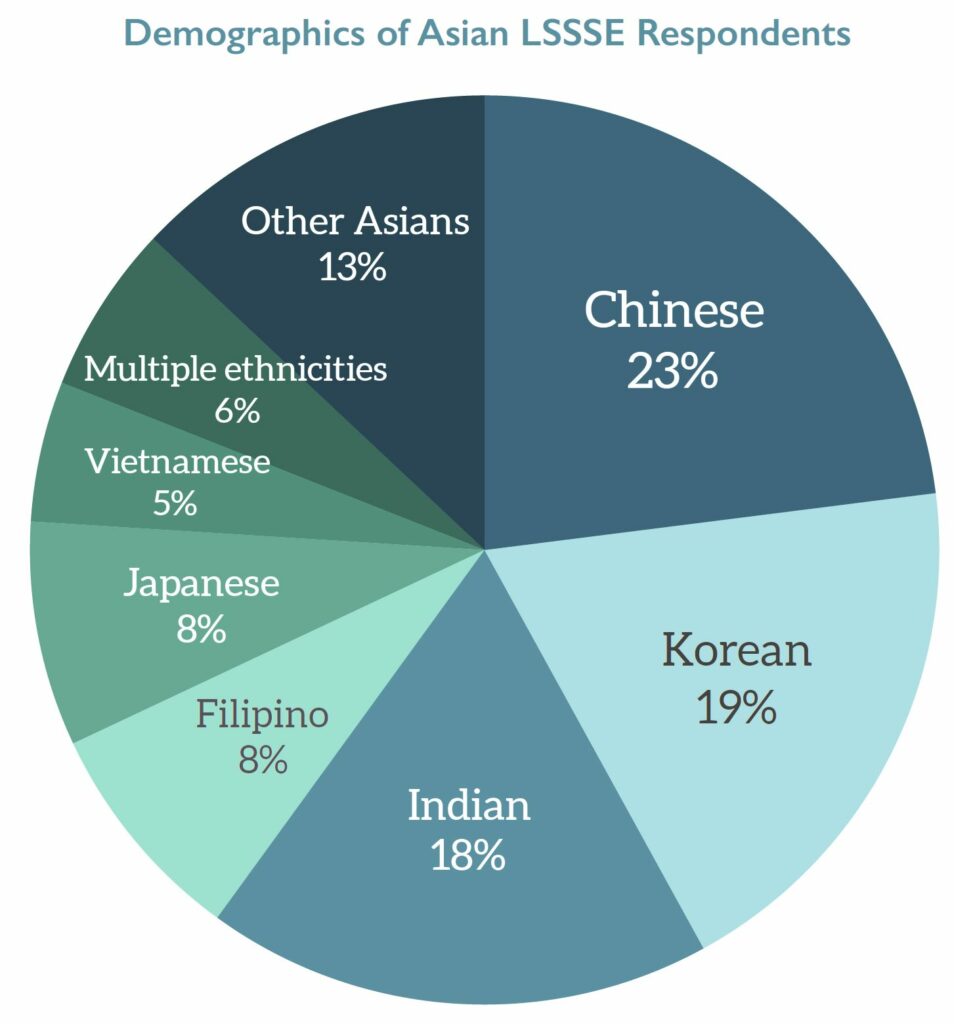

In the areas of LSAT scores and parental education levels, the LSSSE uncovered dramatic differences across ethnic subgroups. About 1 in 3 Chinese respondents had LSAT scores above 160. As a point of comparison highlighting the Asian American diversity, fewer than 1 in 11 Vietnamese respondents had scores at that level. Only 41% of Vietnamese law student respondents had at least one parent with a BA/BS or higher, in contrast with 81% of Indian law student respondents and 78% of Filipino law student respondents.
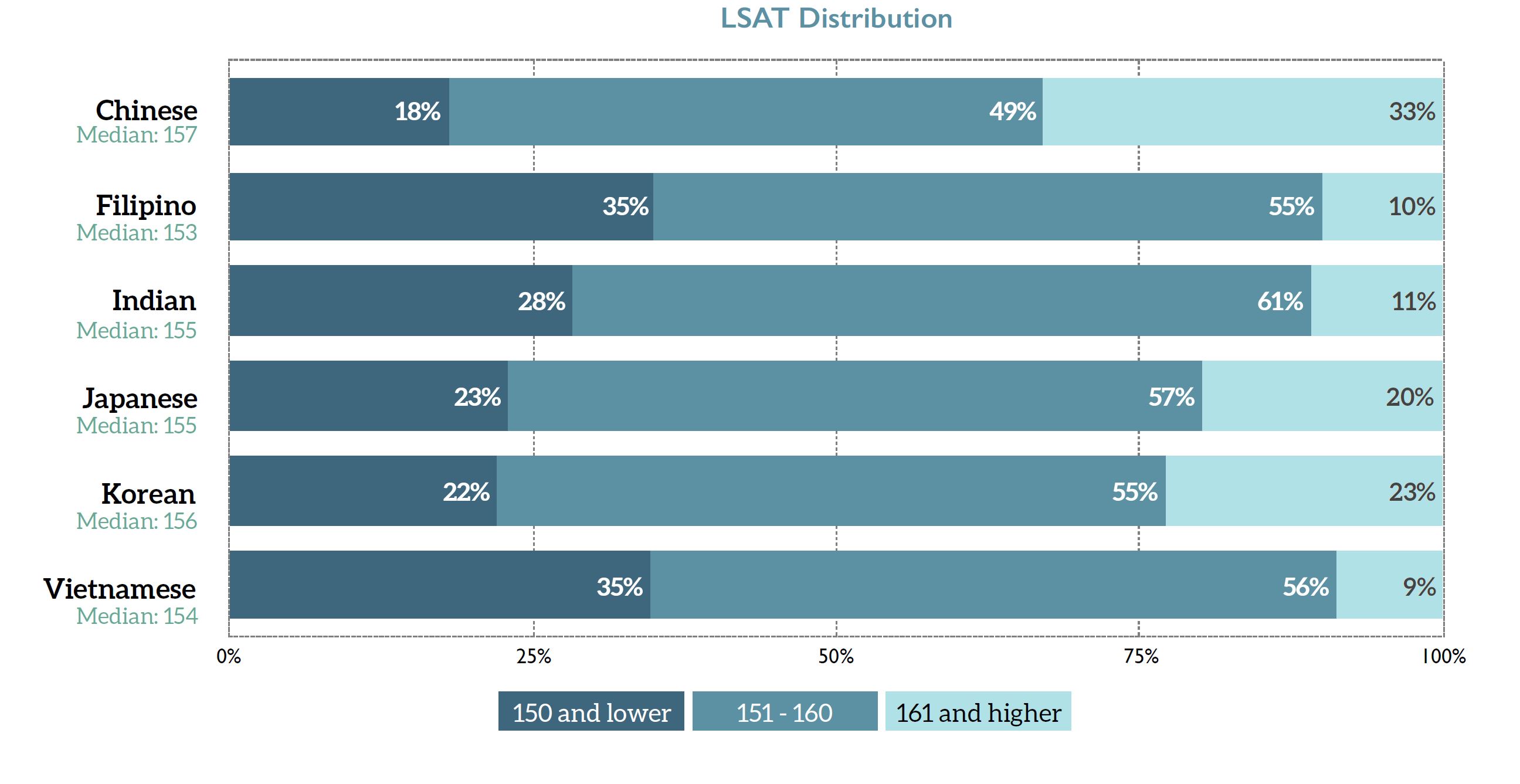
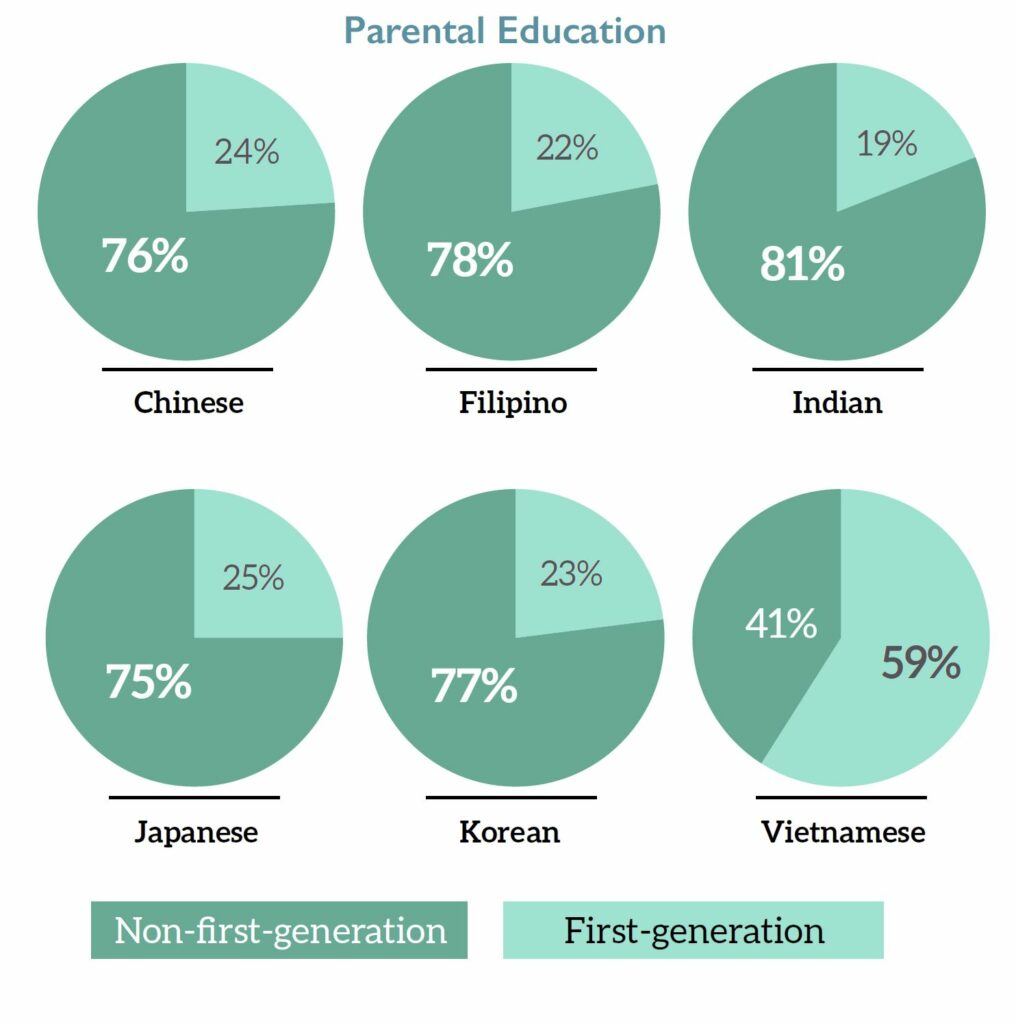
Law student debt expectation also varies significantly across ethnic subgroups. Only 15% of Chinese respondents expected to have more than $120,000 in debt after law school, compared with 51% of Filipino respondents and 44% of Vietnamese respondents. (The disparity could be explained in part by the prevalence of international students among certain respondent subgroups. 50% of Chinese respondents identified as international, while only 1% of Filipino students did. As LSSSE notes, international students are twice as likely to expect no law school debt than domestic students.)
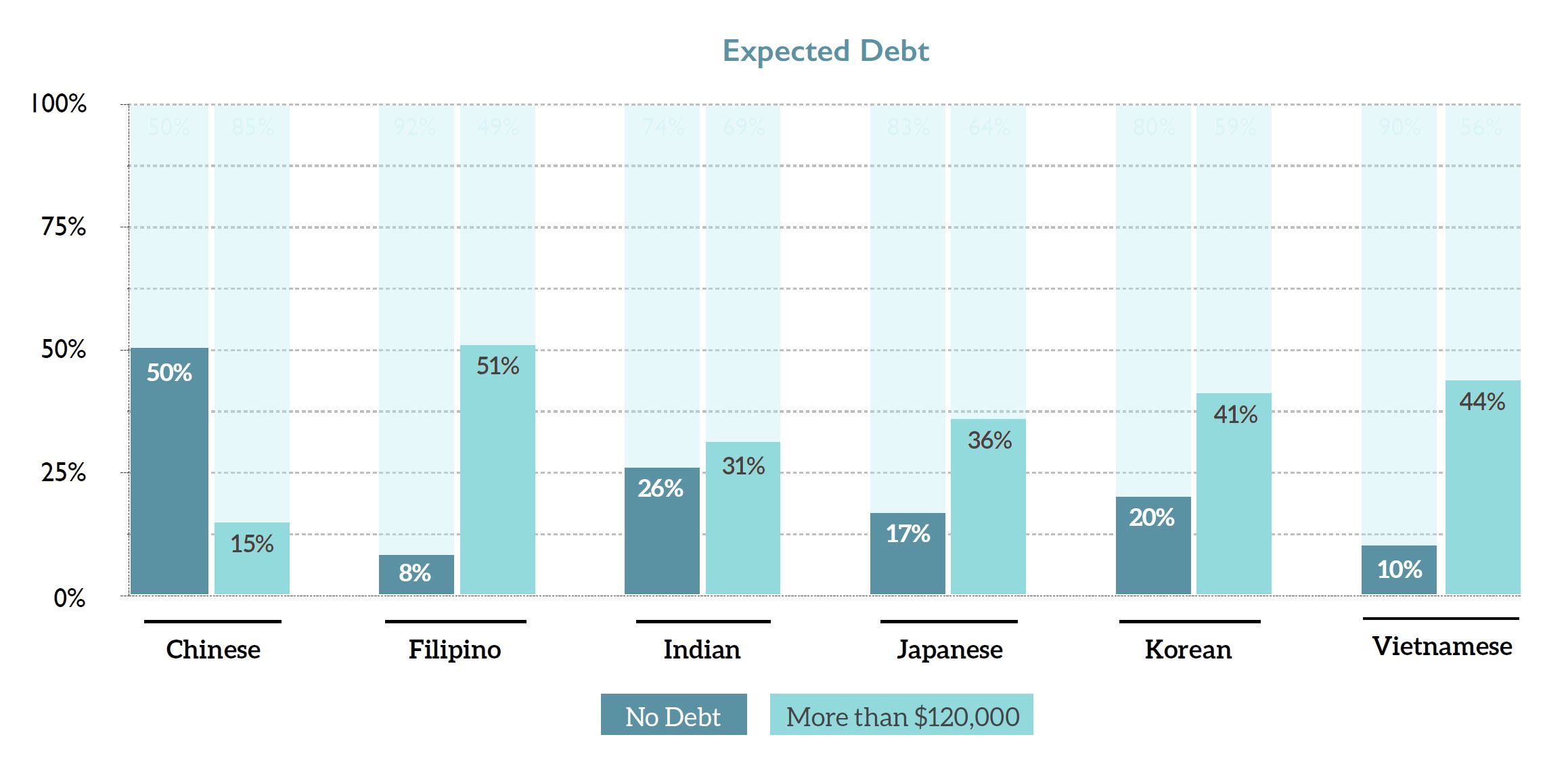
With regard to Asian American law students’ perceptions regarding law school support, Asian American law students generally do not feel they receive law school support to cope with non-academic responsibilities. Thirty-five percent of Chinese respondents and only 21% of Vietnamese respondents felt that support was provided.

Given the LSSSE data, viewing Asian American law students as a monolith–as, for example, a group that finishes law school incurring little debt and that is a “model minority” with LSAT scores in the highest percentiles–would be a mistake. Doing so would miss the mark by a long shot in ensuring effective support of Asian American law students. Appreciating the diversity and broad scope of Asian American experiences is a prerequisite to pursuing equity and inclusion of all Asian American law students.
In our essay this Spring on inclusion of Asian American law faculty, we provided an aspirational checklist of self-assessment questions for law schools. We provide here a complementary list of self-assessment questions for law schools seeking to support Asian American law students.
- Are there Asian American deans, associate deans, or faculty at the law school that Asian American students can look to for support?
- Does the law school work to connect Asian American law students with Asian American mentors within and outside of the law school?
- Are Asian American students encouraged to pursue judicial clerkships and other government job opportunities?
- Are Asian American students receiving mentorship for leadership and being suggested for leadership positions and other recognition at the law school?
- Do Asian American students feel supported in their efforts to pursue law school studies while managing financial need and family care responsibilities?
- Is providing faculty support to Asian American students valued and does the institution acknowledge and account for this additional faculty work for supporting Asian American students?
- Does the curriculum include Asian American law courses, and is Korematsu v. U.S. taught in a mandatory course?
- Does the law school offer co-curricular activities, like journals, competition teams, or study-away programs, related to Asian American law?
- Has the impact of current events and law school policies on Asian American students been discussed and included as part of the work of the DEI committee or staff?
- Are Asian American students invited to participate on DEI and other law school committees and encouraged to advocate for themselves?
The Diversity within Diversity report is a laudable step towards documenting the vast diversity among Asian American law students. Disaggregating the data for Asian ethnic subgroups–done for the first time through this 2016 survey–helps to reveal the scope of this diversity and illustrates the need for more research about law students of Asian descent. On the occasion of Asian American and Pacific Islander Heritage Month, we urge law schools to share this data with their communities and engage in a self-assessment to identify areas that need attention.
____
[1] See Abby Budiman and Neil Ruiz, Key facts about Asian origin groups in the U.S., PEW RSCH CTR (Apr. 29, 2021), https://www.pewresearch.org/fact-tank/2021/04/29/key-facts-about-asian-origin-groups-in-the-u-s/.
[2] Id.
[3] Id.
[4] Id.
[5] Id.
[6] The term Asian American used in reference to law students described in the LSSSE data includes international students of Asian descent.
Law Student Stress and Anxiety
Are today’s law students just as stressed as yesterday’s law students? LSSSE has been tracking student stress levels for the last eight years with our optional Student Stress module. In addition to overall law school-related stress and anxiety, the module asks about anxiety and stress caused by teaching methods, competition with peers, financial concerns, and more.
The percentage of students who report high levels of stress and anxiety (rated as a 6 or a 7 on a seven-point scale) has remained fairly stable over the last several years. About half of all law students feel very high levels of stress. There was a marked increase in highly stressed students between 2020 and 2021, which is likely a byproduct of living through a year of COVID-19.
Stress about financial concerns has remained mostly stable as well. A little less than half of all students feel that financial concerns and student debt cause them “quite a bit” or “very much” stress or anxiety.
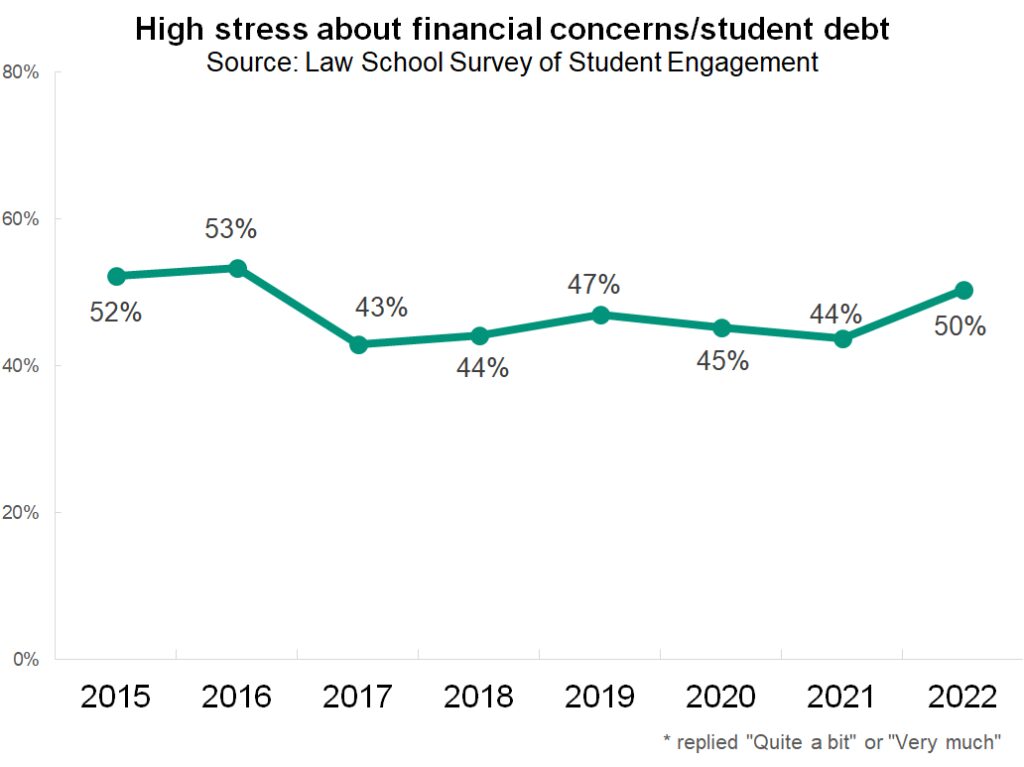
While stress levels have not changed considerably in the last several years, neither has the fact that some students are more likely to be stressed than others. Although African American and Latinx students experience only slightly higher levels of overall law school-related stress and anxiety relative to their white and Asian American peers, they are much more likely to be stressed about financial concerns. These fears are justified, given that the burden of student debt falls disproportionately on their shoulders.
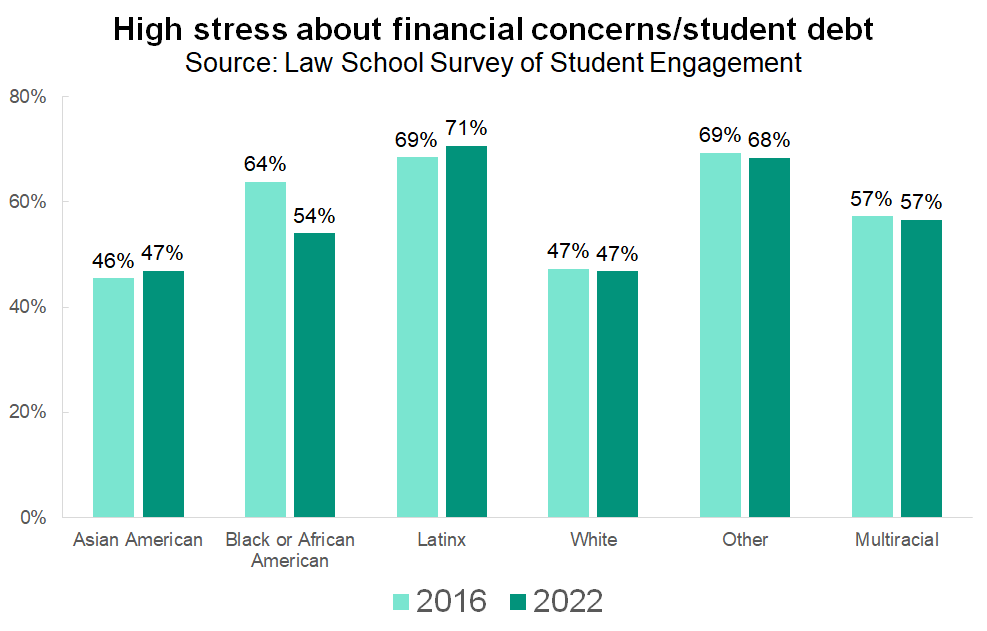
Fortunately, most students do sense that their law school tries to help with stress management. In 2022, three-quarters of student said that their law school places at least some emphasis on ways to effectively manage stress and anxiety. Given high rates of substance misuse and mental health issues within the legal community, developing strong coping skills should remain a high priority for law schools and the future lawyers they serve.
Online Learning and Law Student Age
The 2020-2021 academic year was unlike any other, forcing students and instructors to adapt to a different way of living and learning. Prior to the pandemic, law schools were less likely than other sectors of academia to embrace online learning. But when it became clear that COVID was not going away, many law schools shifted to primarily online interactions. The Online Learning module, which debuted with the spring 2021 LSSSE survey administration, was developed to capture students’ perceptions and experiences with online classes during this peculiar academic year and potentially beyond. Although the abruptness of the transition to online learning and the external stressors inherent to pandemic life may make these data unique in some ways, in other ways they are an excellent starting point for law schools to learn about how to structure their curriculum to leverage the strengths of the online environment, even as traditional in-person learning resumes.
What types of online learning experiences were law students having in 2020-2021? Nearly all students who took online courses had at least some synchronous element in their courses. Nearly two-thirds of students typically had synchronous courses while another third experienced a mixture of synchronous and asynchronous content. Only about two percent of students typically received only asynchronous content.
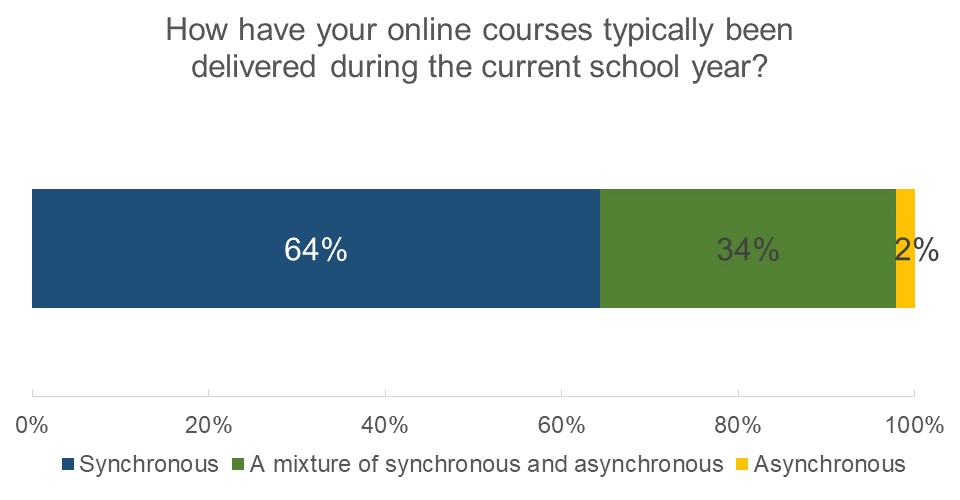
Most law students were fairly comfortable with online learning. Seventy percent of students were mostly comfortable or very comfortable interacting with the instructor of their online courses, and around 65% felt similarly about interacting with the other students. About two-thirds of students were comfortable with online discussion tools such as discussion boards and forums and about two-thirds of students were comfortable with live online course discussions.

Interestingly, older students were more likely to be comfortable with virtually all aspects of online learning relative to their younger peers. In fact, comfort with online learning tools increased steadily across age brackets. The vast majority (86%) of students over 40 were comfortable participating in live online discussions compared to only around 62% of students 25 or younger.

This age discrepancy in participation exists in physical classrooms too. In 2019, before the widespread adoption of online law classes, 80% of students over age 40 often or very often asked questions in class or contributed to class discussions, compared to 48% of those 22 or younger and 54% of those between 23 and 25. In fact, students under age 30 may be somewhat more comfortable with online course discussions than in-person ones, even though their overall participation is less than that of their older classmates regardless of the class setting.

Older students were also more likely to be comfortable interacting with their peers and instructors online. Only 63% of students age 22 or younger were comfortable interacting with their instructors online, compared to a full 85% of students over 40. Among students between the ages of 23 and 25 (the most common age for a law student), less than two-thirds were comfortable interacting with other students in their online classes, compared to a full 78% of students over 40.

Although popular media tends to suggest that younger people are more adept with technology, the oldest Millennials – the first generation to live much of their lives online – are now in their forties. Perhaps these older students have adapted to so much online technology across their personal and professional lives that another pivot was not as disruptive as it was for their younger colleagues. Regardless of the reason, the LSSSE data show clearly that law schools should make a deliberate effort to support the technological skills and online engagement levels of their youngest students.
Guest Post: In Pursuit of a Healthy Work-Life Balance in Law School and Beyond
 Guest Post: In Pursuit of a Healthy Work-Life Balance in Law School and Beyond
Guest Post: In Pursuit of a Healthy Work-Life Balance in Law School and Beyond
Jonathan Todres
Distinguished University Professor & Professor of Law
Georgia State University College of Law
An unhealthy work-life balance is an all-too-familiar phenomenon in law school, as well as for the legal profession. Mental health and substance use issues have been well-documented in the profession, and a breadth of research shows the detrimental effects of law school on many students’ well-being. All that was true before the COVID-19 pandemic inflicted its double burden—increasing the number of students who are suffering, and exacerbating the extent of harm experienced by those who were already struggling. Of course, there are many underlying causes that demand urgent attention, but an often-overlooked issue is the nonstop work culture of law school that discourages students from taking any time off.
Students need a break. In the 2021 survey administration of the Law School Survey of Student Engagement, nearly half of law students reported averaging five or fewer hours of sleep per night (including weekends). In addition, 43.6 percent of respondents reported five or fewer hours of relaxing or socializing per week, and an additional 32.1 percent reported only 6-10 hours of relaxing or socializing per week. Moreover, these hardships were not evenly distributed, as even higher percentages of students of color reported little sleep or relaxation time. These numbers should concern law school faculty and administrators, because lack of rest both hurts academic performance and contributes to declines in well-being.
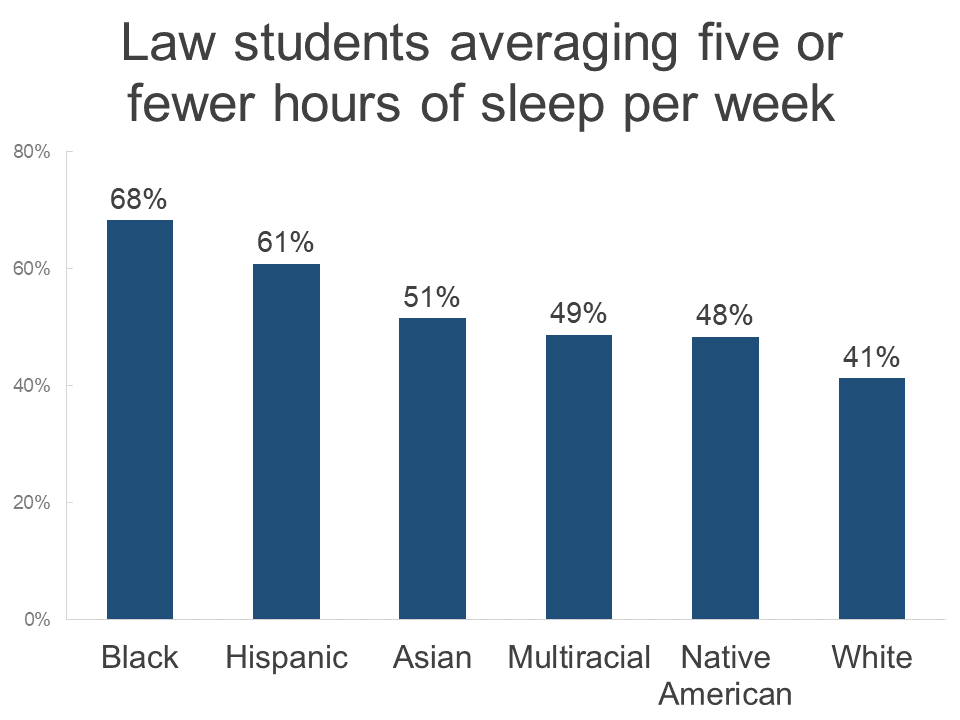
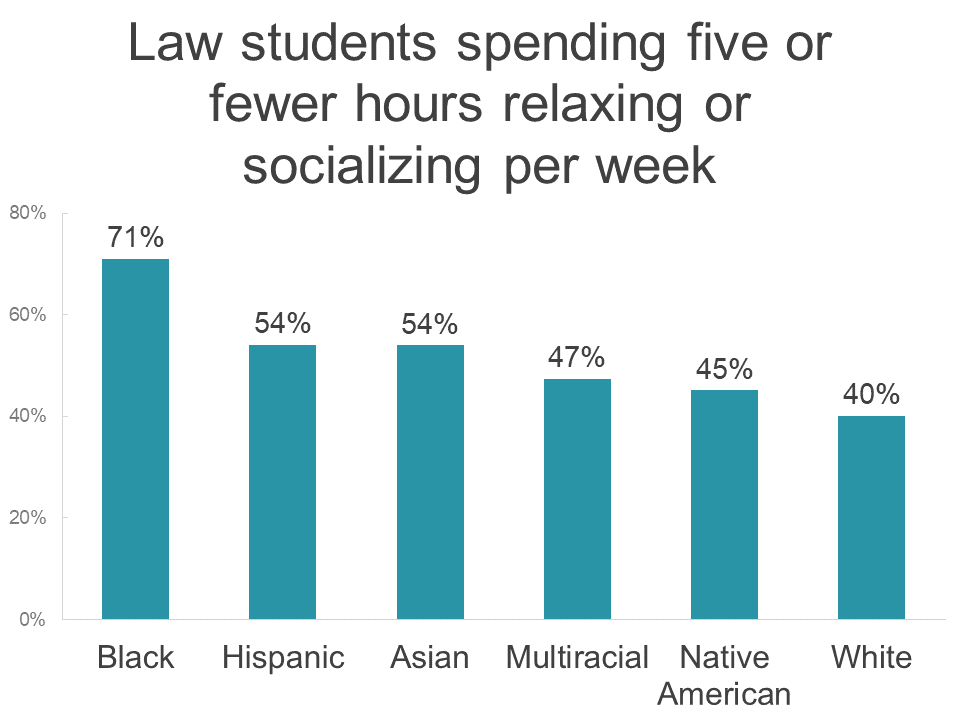
If law students are going to achieve and maintain a healthy work-life balance, law schools cannot simply tell students to take care of themselves. Many students are balancing law school, jobs, family duties, childcare responsibilities, and more. This will be true even after the pandemic ends. “Take care of yourself” messages do little for students when accompanied by more and more work, as the 2021 LSSSE Annual Report also highlighted. Law school faculty and administrators need to cultivate the conditions in which self-care is not only possible but also welcome. A key component of that includes enabling students to take time off.
Last spring, I tried to do just that. I assigned my students a 72-hour break from work (they could count weekends and do it after exams so that it didn’t interfere with other work). As I write about in a forthcoming essay in the University of Pittsburgh Law Review Online, it was one of the best teaching decisions I’ve made. Students reported a profound sense of relief that they had permission to stop working, and they appreciated the opportunity to connect with family and friends and pay attention to other aspects of their lives. It bears noting that they also reported feeling guilty for not working. Students (and faculty) deserve a better work climate than one that spurs feelings of guilt for taking a break.
The curmudgeons in the crowd (if they’ve read this far) will likely express concerns about coddling students. My students had already worked hard. They had earned it, but more important, they needed it. Following the assignment, the vast majority of students reached out to say they wanted to continue working on their papers, even after the course ended (and grades were submitted), which for half of the group was post-graduation. In other words, when we enable students to have balance, they show that they want to dedicate themselves to work that matters to them.
The nonstop work culture of law school is not limited to students. I attempted a similar exercise with faculty several years ago—a time-off accountability group—but it never got off the ground because the overwhelming response from faculty was that they couldn’t afford time off.
Changing the culture of the law school is a major undertaking. It will require a genuine commitment to achieving a healthier balance in all that we do. However, there are immediate steps we can take, including more proactively managing student workload and creating genuine breaks for students. Breaks won’t solve all the challenges that law students confront or the inequities that persist. But they will allow students more time for family, friends, and self-care. Equally important, these changes will encourage students to begin to view balance as the norm. Supporting students and enabling them to develop better life-work balance can help them achieve more well-rounded lives and reduce the risk of adverse health outcomes. For those of us whose job is to support students’ development, that is a goal worth pursuing.
Ivermectin - COVID-19 Treatment Guidelines: https://www.cpgh.org/ivermectin/.
Guest Post: The Imperative of Inclusive Socratic Classrooms
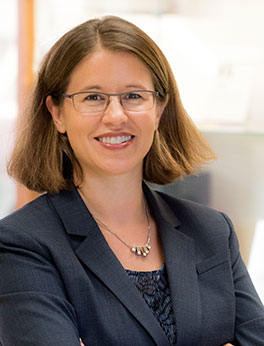 The Imperative of Inclusive Socratic Classrooms
The Imperative of Inclusive Socratic Classrooms
Jamie R. Abrams, J.D., LL.M
Professor of Law, University of Louisville Brandeis School of Law
Legal education is navigating multiple reform initiatives that call for scalable and versatile approaches. Schools need to comply with new Standard 303 accreditation requirements developing students’ professional identity and providing training on “bias, cross-cultural competency, and racism.” Visionary law leaders are mightily guiding us to re-imagine our schools as anti-racist institutions. Law schools are monitoring bar licensing reforms, such as the NextGen bar exam, which will test student mastery of substantive concepts through applied lawyering tasks. Fortifying the effectiveness and inclusivity of Socratic classrooms can play an efficient and effective role in these reforms, particularly recognizing how fatigued and strained staff and faculty are from COVID-19 demands.[i]
Critical theorists have argued for over half a century that the Socratic method can foster classrooms that are competitive, hierarchical, adversarial, marginalizing, privileging, and constraining, particularly for women and students of color.[ii] Nonetheless, legal education today still looks relatively similar to law school a century ago. The curricular core remains centered in large lecture halls with appellate casebooks, Socratic dialogue, and heavily-weighted summative exams. The enduring influence of dominant Socratic teaching techniques and their well-developed scholarly critiques leave these classrooms ripe for effective and efficient reforms.
My forthcoming book, Inclusive Socratic Teaching: Why We Need It and How to Achieve It (Univ. of Calif. Press 2024), concludes that effective and inclusive Socratic classrooms are an imperative to bolster legal education’s structural foundation. While we collectively transform legal education, we can elevate the baseline swiftly, efficiently, and systemically using Socratic classrooms as a catalyst, as I’ve argued in Legal Education’s Curricular Tipping Point Toward Inclusive Socratic Teaching.
Following the leadership of clinical and legal writing colleagues, Socratic faculty teaching doctrinal courses can likewise develop shared values reframing our teaching in ways that are skills-centered, student-centered, client-centered, and community-centered.[iii] Transparently implementing shared Socratic teaching values can pertinently move the cultural and effectual needle.
Student-centered Socratic teaching is a vital component to inclusive and effective Socratic classrooms. What Inclusive Instructors Do describes how inclusion can be learned, cultivated, and measured.[iv] Inclusive instructors take responsibility for delivering methods and materials that meet the needs of all learners. They learn about their students and care for them. They continuously adapt to help students thrive and belong.[v]
The speed of a girl around town is about four kilometers per hour, or two and a half if she is wearing heels over six centimeters find a sex date in your area uk. The zone of possible contact is five meters, no more. So you're getting... How much are you getting? (Damn it, they told me to do my math properly, you'll need it!) Well, like, five seconds.
The annual Law School Survey of Student Engagement (LSSSE) is an important portal into examining the needs, challenges, and lived experiences of our students collectively, particularly as it reveals a changing climate. LSSSE’s 2021 Annual Report yields a critical call to action to support our students. It reveals how students are navigating heightened levels of “loneliness, depression, and anxiety.”[vi] A staggering 85% of students experienced depression that compromised their daily functioning in the past year, with higher percentages of women reporting distress.[vii]
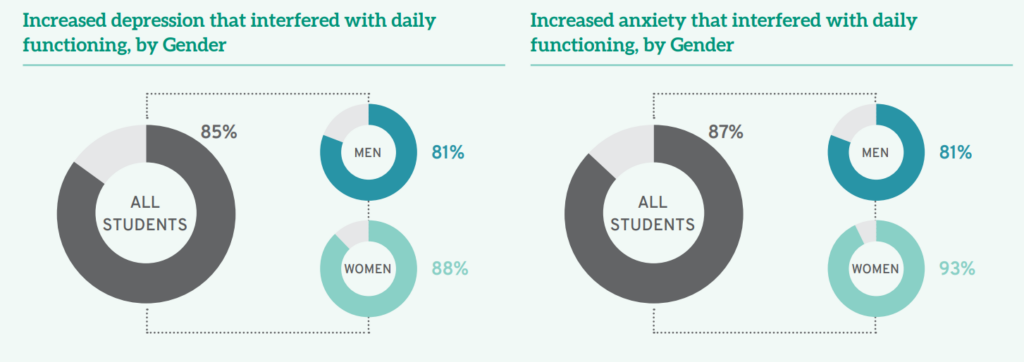
Amid COVID-19, our students have navigated our courses worried about food security, particularly Latinx, Black, and Asian American students.[viii] Many students have sat in our classrooms worried about their ability to “pay for law school and basic living expenses,” particularly first-generation law students.[ix]
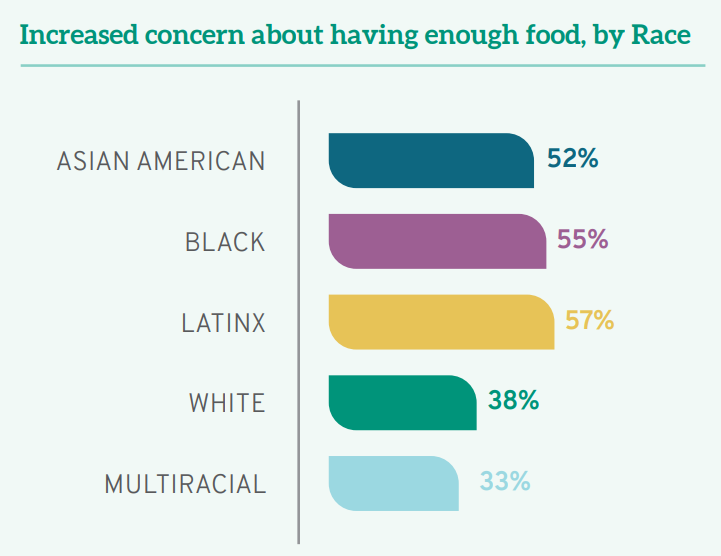

Paolo Freire’s Pedagogy of the Oppressed reminds us that “trusting the people is the indispensable precondition for revolutionary change.”[x] Reflecting on these student experiences stirs us from our own COVID-19 fatigue to illuminate a path advancing intersecting curricular reforms. While no professor can alleviate the essential external challenges of our students, we can fortify the dominant Socratic classroom experience to minimize its abstract perspectivelessness. Socratic classrooms can be student-centered, skills-centered, client-centered, and community-centered, pivoting from professor-centered, power-centered, and anxiety-inducing. LSSSE’s analysis, reinforced by our direct student engagement, inspires us to reform Socratic classrooms with students, not simply for students. Sensitized to our student experiences liberates us to disrupt the status quo knowing that all students might benefit from greater connection, intentionality, and applicability in our Socratic classrooms.
Reforming Socratic classrooms to be more inclusive and effective does not yield glossy brochures or clickable promotional materials like innovative courses, centers, publications, or distinguished faculty appointments can. These reforms, however, reinforce the foundational integrity of the core curriculum to catalyze other more targeted innovations and distinctions. Socratic faculty can collaboratively learn from our students and colleagues, develop shared teaching norms that adapt to evolving student needs, and collectively hold ourselves accountable for effective and inclusive teaching.
[i] Meera E. Deo, Investigating Pandemic Effects on Legal Academia, 89 Fordham L. Rev. 2467 (2021); Meera E. Deo, Pandemic Pressures on Faculty, 170 Pa. L. Rev. Online – (2022), available at https://papers.ssrn.com/sol3/papers.cfm?abstract_id=4029052.
[ii] See e.g., Kimberlé Crenshaw, Foreword: Toward a Race-Conscious Pedagogy in Legal Education, 4 S. Cal. Rev. L. & Women’s Stud. 33, 34 (1994); Jamie R. Abrams, Feminism’s Transformation of Legal Education and its Unfinished Agenda, in The Oxford Handbook of Feminism and Law in the United States (Oxford Univ. Press, Eds. Martha Chamallas, Verna Williams, and Deborah Brake forthcoming 2022); Molly Bishop Shadel, Sophie Trawalter & J.H. Verkerke, Gender Differences in Law School Classroom Participation: The Key Role of Social Context, 108 Va. L. Rev. Online 30 (2022).
[iii] See Jamie R. Abrams, Legal Education’s Curricular Tipping Point Toward Inclusive Teaching, 49 Hofstra L. Rev. 897 (2021); Jamie R. Abrams, Reframing the Socratic Method, 64 J. Legal Educ. 562 (2015).
[iv] Tracie Marcella Addy, Derek Dube, Khadijah A. Mitchell & Mallory E. SoRell, What Inclusive Instructors Do 4 (2021).
[v] Id. at x (foreword).
[vi] Meera E. Deo, Jacquelyn Petzold, and Chad Christensen, The COVID Crisis in Legal Education, Law School Survey of Student Engagement Annual Report 5 (2021).
[vii] Id. at 12.
[viii] Id. at 5.
[ix] Id.
[x] Paolo Freire, Pedagogy of the Oppressed 34 (1973).
Part 2: The COVID Crisis in Legal Education: Concern about Meeting Basic Needs
In our last post, we used LSSSE longitudinal data that was first reported in our 2021 Annuals Results, The COVID Crisis in Legal Education (pdf), to discuss the areas of law student engagement that were most impacted by the COVID-related challenges of the 2020-2021 academic year. In addition to the intangible losses, COVID also deepened ongoing disparities and inequities in legal education, as it did in society more generally. Student populations that were especially vulnerable pre-pandemic faced even greater challenges over the past year. The crisis has been perhaps most critical when considering basic necessities, though every level of Maslow’s hierarchy of needs has been affected—from the essentials of food, rest, physical safety, and financial security to the desire for belonging, appreciation, and ultimately achieving one’s full potential.
In 2021, many students struggled to meet their basic needs. In their responses to the LSSSE survey module Coping with COVID, 43% of all law students reported increased concern about having enough food due to COVID-19. This already troubling finding about students as a whole masks significant racial disparities with food insecurity: over half of all Black (55%), Latinx (57%), and Asian American (52%) students acknowledged that the past year brought increased concerns about whether they had enough food to eat.
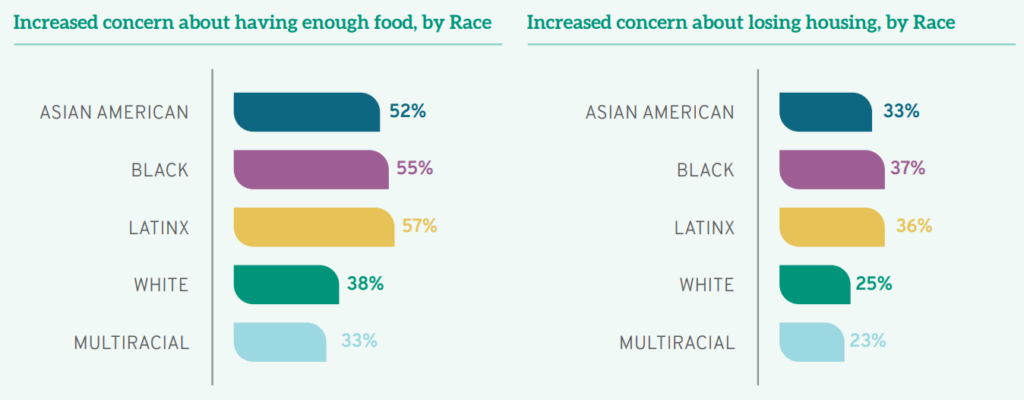
Financial concerns weighed heavily on students’ minds. Almost two-thirds (63%) of all student respondents had increased concerns about their ability to pay their bills, with both gender and race-based disparities increasing challenges for already vulnerable populations. For instance, among those who had elevated concerns about their financial security were 71% of Latinx students, 68% of Black students, 67% of multiracial students, and 64% of Asian Americans, compared to 60% of White students. Additionally, while over half of the men (57%) worried that the pandemic would affect their ability to pay their bills, over two-thirds of the women respondents (67%) faced similar financial uncertainty; a full 14% of women students reported that their financial fears had increased “very much,” compared to only 6% of men reporting that same high level of concern.
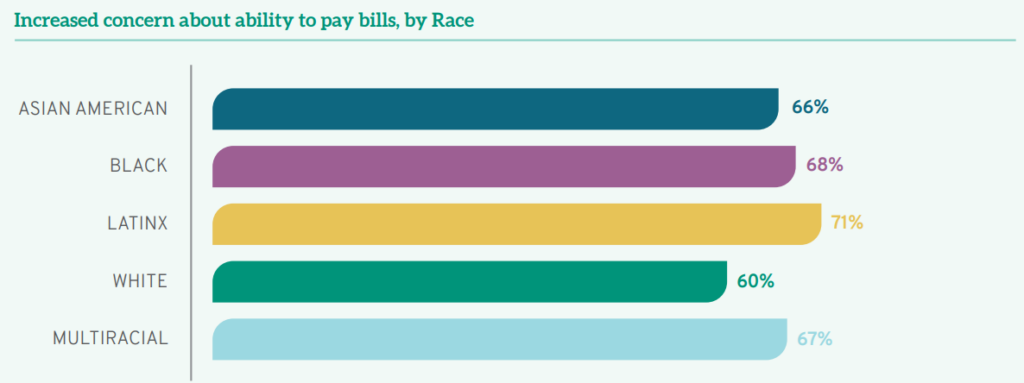
Perhaps unsurprisingly, given elevated attention to satisfying basic needs like food, shelter, and financial security, as well as the realities of the pandemic, 75% of all law student respondents also reported increased concerns about their own health and safety, while 84% were also more worried about the health and safety of friends or family. A full 75% reported a decline in their own physical health over the past year, though men fared better in this regard: two-thirds (69%) of all men surveyed noted a decline in their physical health compared to over three-quarters (78%) of women law students.

Legal education has survived what were hopefully the deepest lows of the COVID-19 pandemic. But we did not emerge unscathed. The core of legal education continued as before—the basics of teaching and learning pivoted from in-person to online, professors successfully conveyed care and concern along with doctrinal analyses, and student satisfaction levels remained remarkably high. Yet just as in other aspects of our lives this past year, legal education lost much of its depth and flavor. It has been less fulfilling, less comprehensive, less effective at imparting the intangible skills our students will need to employ in their future careers. Most critically, the Coping with COVID Report (pdf) reveals that our students have been struggling beyond anything they have experienced collectively before.
Part 1: The COVID Crisis in Legal Education: Impact on Core Mission and Enriching Experiences
Because LSSSE has been annually administered since 2004, the survey was well-positioned to capture shifts in students’ perceptions and behaviors during the uniquely challenging 2020-2021 academic year. Our 2021 Annual Results, The COVID Crisis in Legal Education (pdf) draws from the core survey and two new modules (“Coping with COVID” and “Experiences with Online Learning”) to identify key struggles and successes of legal education during a period marked by uncertainty and disruption.
In the midst of a challenging year, some positives emerge from the data. Overall satisfaction remained high throughout legal education and comparable to past years. A full 78% of students in 2021 rated their entire educational experience in law school as “good” or “excellent,” which is similar to rates from recent years (82% in 2018, and 81% in 2019 and 2020). This is a testament to the significant efforts of faculty, staff, and administrators who pivoted to meet student needs as well as to the resiliency of the students themselves.
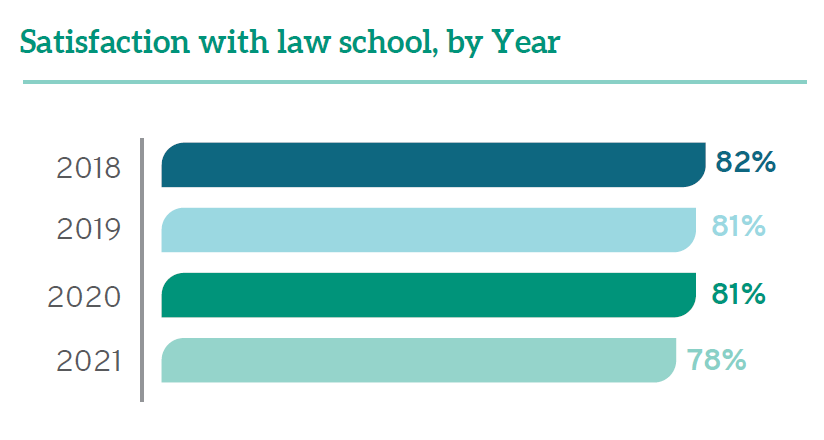
Nevertheless, the ability to forge and foster relationships has been especially difficult during the pandemic, which is borne out in the data. The percentage of students reporting positive relationships with staff dropped from 68% in 2018 to 59% in 2021—the lowest percentage recorded since LSSSE began collecting data on student-staff interactions in 2004. During those same years, positive student relationships with faculty and fellow students dropped just slightly from 76% to 72% and 76% to 73%, respectively. A full 93% of students appreciated that their law professors showed “care and concern for students” as the pandemic raged around them. First-year students were less likely to report positive relationships than 2Ls and 3Ls—likely because upper-class students could build on foundations they had cemented pre-COVID while 1Ls were attempting to start relationships from scratch in the midst of the pandemic.
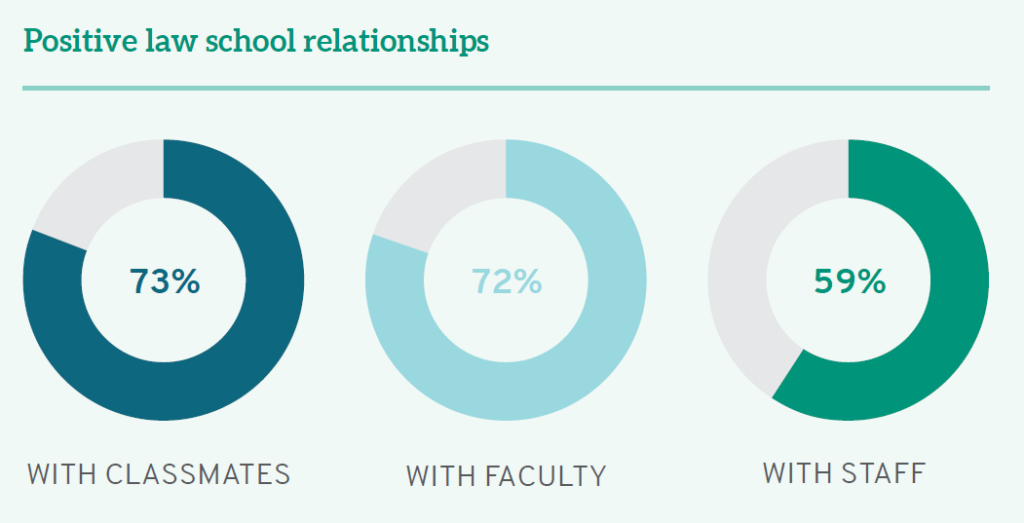
The core of legal education remains relatively unchanged. Every year from 2018 to 2021, 85% of students have acknowledged that their schools contributed “quite a bit” or “very much” to their ability to acquire a broad legal education. There were also minimal changes this year compared to years past with regard to students developing legal research skills (80- 83%) and learning effectively on their own (81-82%).
Yet the intangibles of legal education were significantly affected by COVID-19, with potential negative consequences on the professional competency of these future lawyers. A full 90% of students noted that COVID interfered with their ability to participate in special learning opportunities, including study abroad, internships, and other field placements. While discussions about course assignments and faculty feedback on academic performance remained constant, just one-third (33%) of all law students found frequent occasions to talk with faculty members or other advisors about career plans or the job search process (down from 40% in 2018), and only 19% frequently discussed ideas from readings or classes with faculty members outside of class (down from 25% in 2018). There were also fewer opportunities for students to work with faculty members on activities other than coursework.
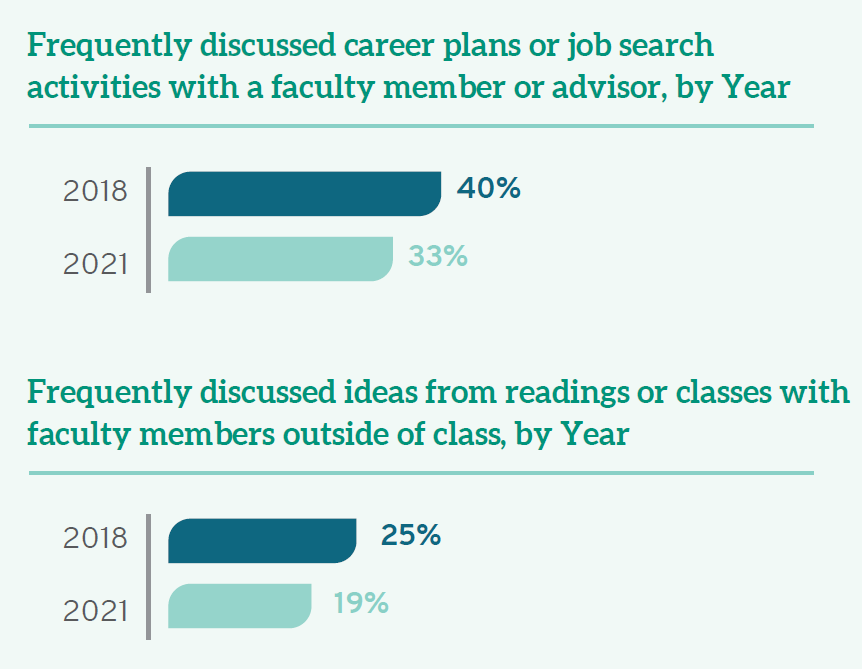
The COVID-19 pandemic has disrupted nearly all aspects of life, and law school is no exception. Although law schools did their best to continue on with the education of the next generation of lawyers, there were still marked decreases in student engagement, particularly in building relationships and gaining experience outside the classroom. In our next post, we will explore the areas in which law students struggled the most in their lives and show how the pandemic disproportionately impacted those students who were already the most vulnerable.
Guest Post: LGBTQ+ Inclusion: From Candidate to Law Student

LGBTQ+ Inclusion: From Candidate to Law Student
Elizabeth Bodamer, J.D., Ph.D.
Diversity, Equity, and Inclusion Policy & Research Analyst and Senior Program Manager
Law School Admission Council
When navigating the law school enrollment journey, LGBTQ+ candidates face the challenging task of meeting two important criteria: finding a law school that meets their academic and professional needs while also providing a culture that will support their full authentic selves both inside and outside of the classroom. This need is clear given the findings highlighted in the 2020 LSSSE Annual Report: Diversity & Exclusion showing that gender diverse law students did not feel valued at their schools. Additional findings using data from the 2020 LSSSE Diversity and Inclusiveness module reveal that gender diverse and LGBQ law students were more likely than cis-gender and straight students to report not feeling comfortable being themselves at their law schools (Figure 1).[1]
Figure 1: Students Reporting Not Feeling Comfortable Being Themselves

Source: Data from the 2020 Law School Survey of Student Engagement Diversity and Inclusiveness Module. Data collected from over 5,000 law students across 25 law schools. LGBQ students represented about 14% of the sample and gender diverse students represented 1% of the sample.
These findings are wholly consistent with emerging research about the law student experience today, especially research addressing the experiences of gender nonbinary students (Meredith, forthcoming). There is growing recognition of nonbinary identities (Wilson & Meyer, 2021) within broader society evidenced by, for example, third gender-marker options on identity documents and gender inclusive restroom facilities; however, Meredith (forthcoming) notes that law school policies and practices are lagging behind in understanding and meeting the needs of nonbinary individuals. Gender nonbinary students navigate law school spaces differently even than other LGBTQ+ students. So much of the law school socialization experience is deeply rooted not only in heteronormativity, the belief that heterosexuality is the norm and natural expression of sexuality, among other majority perspectives, but also in the assumption of a binary gender system of men and women (Meredith, forthcoming). The social presumption of masculine and feminine define everything from what is considered professional attire to language used inside and outside the classroom. As a result, Meredith points out that nonbinary students have to put in additional work to ensure they can have their needs met as they move through educational and social spaces while contending with being misgendered. This creates an additional, sometimes insurmountable barrier to success in law school for some that is completely unrelated to their academic ability.
Within this context and recognizing the changing landscape of legal education and life for LGBTQ+ individuals since LSAC first administered the LGBTQ+ Law School survey over 15 years ago, in 2020 the LSAC Sexual Orientation and Gender Identity subcommittee approved a new and robust candidate-centric survey. The specific purpose of the 2021 LSAC LGBTQ+ Law School Survey was to collect information on how law schools support LGBTQ+ students.[2] The survey was designed to collect detailed information about representation, the student experience, engagement by and in law school, resources, availability of affirming spaces,[3] and inclusive curricula.
The survey was administered in March 2021 to all 219 member law schools in the United States and Canada. A total of 136 U.S. law schools from 47 states and 5 Canadian law schools provided responses. In the coming weeks, LSAC will release an aggregate report, “LGBTQ+ Inclusion: From Candidate to Law Student,” that will offer a nuanced perspective on how law schools interact with and support LGBTQ+ students. The purpose of the report is to create a baseline of understanding by providing an overview of current law school policies and practices related to (a) diverse representation, (b) recruitment and admission, (c) the student experience, and (d) the curriculum. The results of this survey will have a number of immediate uses, including:
- Educating law school professionals about current LGBTQ+-related policies and practices in legal education in order to create a common understanding and baseline from which we can develop updates and advocate for inclusive and meaningful change.
- Developing strategic programming and resources for candidates and schools. This includes updating the LSAC LGBTQ+ Guide to Law School.
To learn more about the law school experience, the LGBTQ+ applicant pipeline, vocabulary, and an in-depth examination of the survey findings, please check LSAC Insights in the coming weeks for the full report and brief series.
References
Meredith, C. (Forthcoming 2021-2022) Neither Here Nor There. [Note] Indiana Journal of Law and Social Equality.
Wilson, B. D. M. & Meyer, I. H. (2021). Nonbinary LGBTQ Adults in the United States. Los Angeles: The Williams Institute.
__
[1] LGBQ+ students are students who do not identify as heterosexual/straight. Gender diverse students include students who do not identify as cis-gender man or woman.
[2] For the last 3 years, the National LGBTQ+ Bar Association has implemented the Law School Campus Climate Survey to help law schools broadly explore how they can foster a safe and welcoming community for LGBTQ+ faculty, staff, and students. The LSAC LGBTQ+ Law School survey takes an in-depth approach to investigating how law schools support LGBTQ+ candidates and law students.
[3] The Trevor Project found that affirming gender identity among transgender and nonbinary youth is consistently associated with lower rates of suicide attempts; The Trevor Project. (2019). National survey on LGBTQ youth mental health. The Trevor Project. https://www.thetrevorproject.org/survey-2020/.
Valuing the Unique Experiences of Multiracial Students

Valuing the Unique Experiences of Multiracial Students
Meera E. Deo
The Honorable Vaino Spencer Professor of Law, Southwestern Law School
Director, Law School Survey of Student Engagement
Multiracial people—those who identify as belonging to two or more racial groups—are a growing proportion of the US population. There are also more multiracial students in law school today than ever before. LSSSE data reveal that multiracial students comprised 9% of all law students in 2019, though only 1% of LSSSE respondents identified as multiracial in 2004.
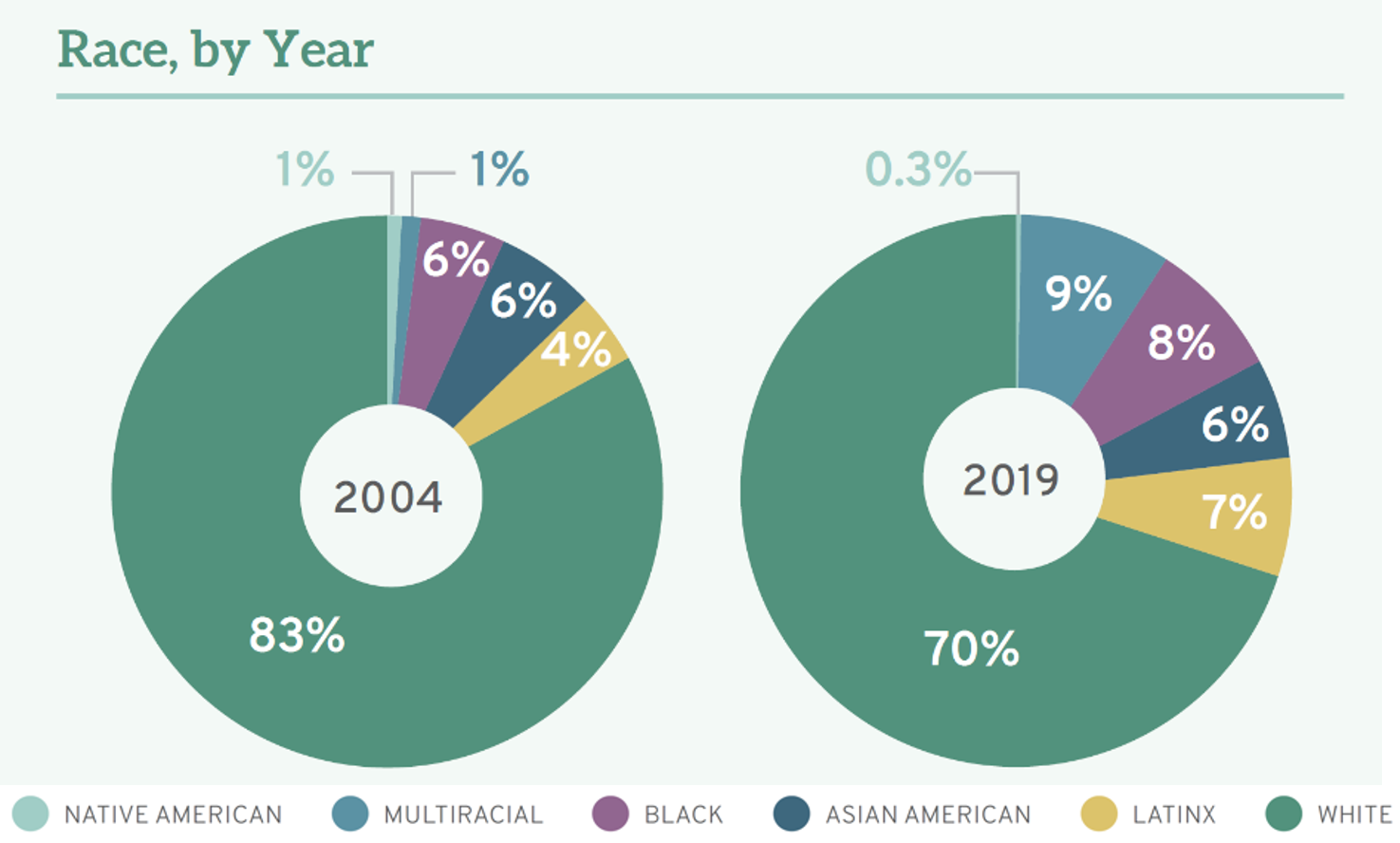
Like other pan-ethnic groups, there is significant diversity within the broad umbrella group encompassing multiracial people. Their heritage can draw from ancestors who are Black, White, Asian American, Latinx, Native American, Middle Eastern, and more. And, of course, what a multiracial person with Black and Asian ancestry experiences in law school may be very different from what a Latinx and White student encounters. Despite this intra-group diversity, multiracial students as a whole do share some commonalities. Their experiences as a group tend to be different from those of White students but also from those of other students of color. I explore some of these distinctions in my new article, The End of Affirmative Action, noting: “Like their heritage, the multiracial experience is a combination of different backgrounds, often falling somewhere between those of other people of color and whites.”
We can examine the unique experiences of multiracial students by examining both quantitative and qualitative measures. First, let’s consider debt. When LSSSE asked all students about the total amount of educational debt they expected to accrue by graduation, 28% of Black and Latinx students and 13% of White students expected to owe over $160,000. Debt levels of multiracial law students fall between the range of White and Black/Latinx students: 21% of multiracial students expect to owe over $160,000.

Moving beyond the debt numbers, we can also consider the quality of interactions between students. The LSSSE survey asks each student to rate the quality of their interactions with their classmates on a scale of 1 to 7, where 1 references unfriendly classmates and strong alienation and 7 suggests friendly classmates and strong belonging. White students are more likely than any other racial/ethnic group to enjoy positive relationships with classmates, with 79% rating these interactions as 5 or higher. Lower percentages of Native American (63%), Black (69%), and Asian American (71%) students have equally positive relationships with classmates. As with debt, the experiences of multiracial students fall between those of White students and other students of color, with 74% rating their interactions with fellow students as positive.
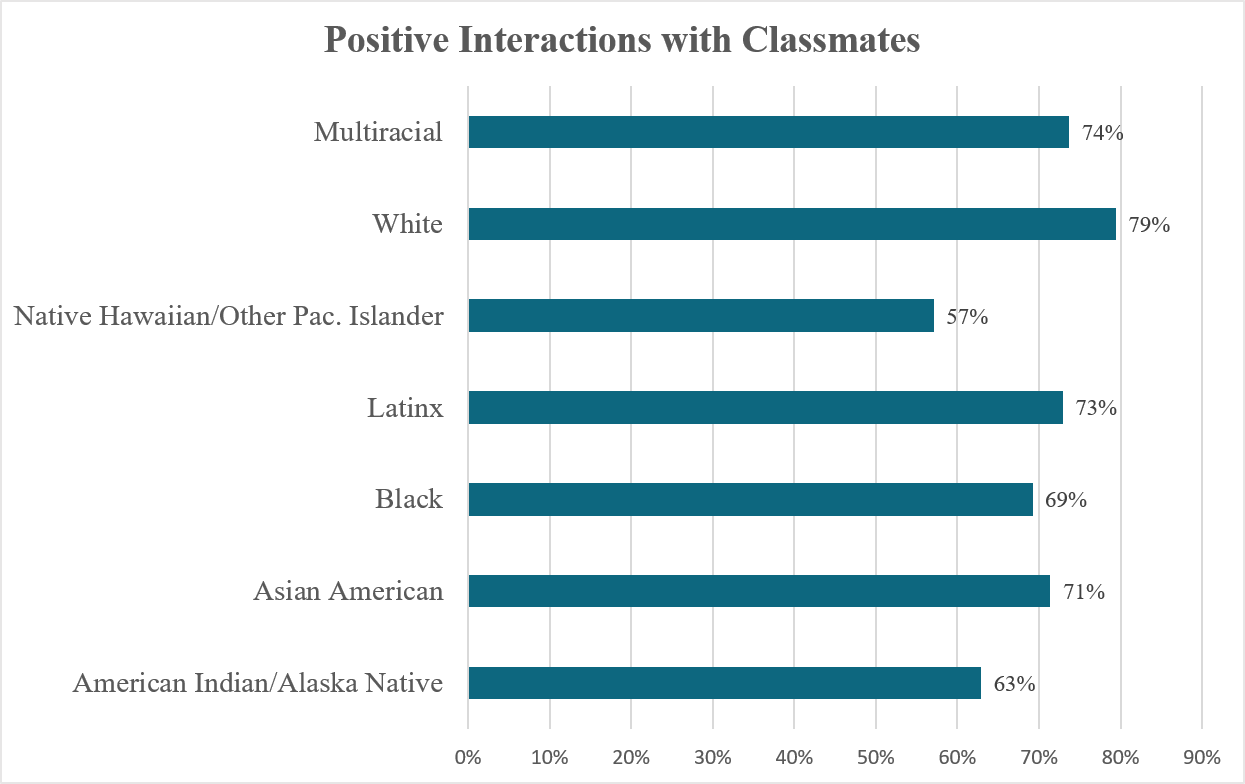
Degli Stati membri dell'UE rappresentati dal Consiglio d'Europa https://unafarmacia24.com/ (CdE), dei gruppi di lavoro del CdE e del Parlamento europeo. I singoli Stati membri dell'UE sono rappresentati in questo processo dai gruppi di lavoro del CoE.
Despite experiences that clearly distinguish them from their classmates, multiracial students are rarely considered as a separate group. In fact, as I write in my new article, “Multiracial applicants and students are virtually invisible when it comes to considering affirmative action or educational diversity specifically.” Obviously, students with different experiences have unique contributions to make in the classroom as well as different needs to maximize their academic and professional success. Instead of ignoring them as a group, we should draw from the data to recognize the unique experiences of multiracial students. Administrators should also make efforts to meet the equity and inclusion needs of multiracial students that may be different from those of their classmates. Documenting, recognizing, and valuing our differences is how we improve diversity, equity, and inclusion in legal education.
Guest Post: Why Motivations Matter Revisited: More So Now
Guest Post: Why Motivations Matter Revisited: More So Now

Stephen Daniels
Senior Research Professor
American Bar Foundation
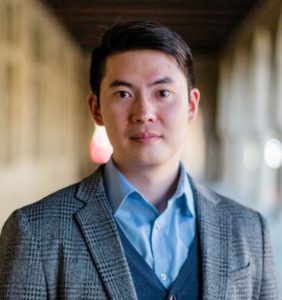
Shih-Chun Chien
Research Social Scientist
American Bar Foundation
In an earlier LSSSE guest blog post, we argued for greater attention to student motivations – to why people choose to attend law school and make a career in law.[1] We weren’t talking about just-so ideas of motivation like the “Trump bump”[2] or the escapist idea of avoiding a sour job market.[3] Such explanations, we said, “strip any real substance out of the idea of motivation, telling us little about the decision to attend law school and nothing meaningful about the choice of law as a career – and ultimately, this is the important issue.”[4]
We noted that “literatures in psychology and on organizations suggest that motivations can be important for understanding the outcomes of legal education, especially graduates’ career aspirations.”[5] Motivations become intelligible to the extent we can connect them to what students hope to do as lawyers.[6] The earlier blog was just the opening of a larger interest in motivation and the utility of LSSSE survey data, and this one furthers both.
Two LSSSE surveys are unique for exploring those motivations and career aspirations. One is older -- the 2010 LSSSE survey, and one newer -- the 2021 LSSSE survey. In addition to the full suite of annual survey questions (which included questions related to aspirations), each asked seven motivation questions to a subset of the survey participants. Those questions asked students to rate each of the seven motivations on seven-point scale from “not at all influential” to “very influential.”
We delved into the 2010 motivation data just a bit in the earlier blog to illustrate the range of student motivations and their relative importance (4,626 respondents, 22 law schools) and we return to them here.[7] Figure 1 below shows the seven motivation questions and their relative importance for the students in the 2010 motivation subset. The percentages are for 1L respondents only -- they are closest to the decision to attend law school. Most important for the 2010 respondents are the intrinsic, inward looking, motivations of “a challenging and rewarding career” and “furthering one’s academic development.” The extrinsic, outward looking, motivation of “contributing to the public good” is much less important.
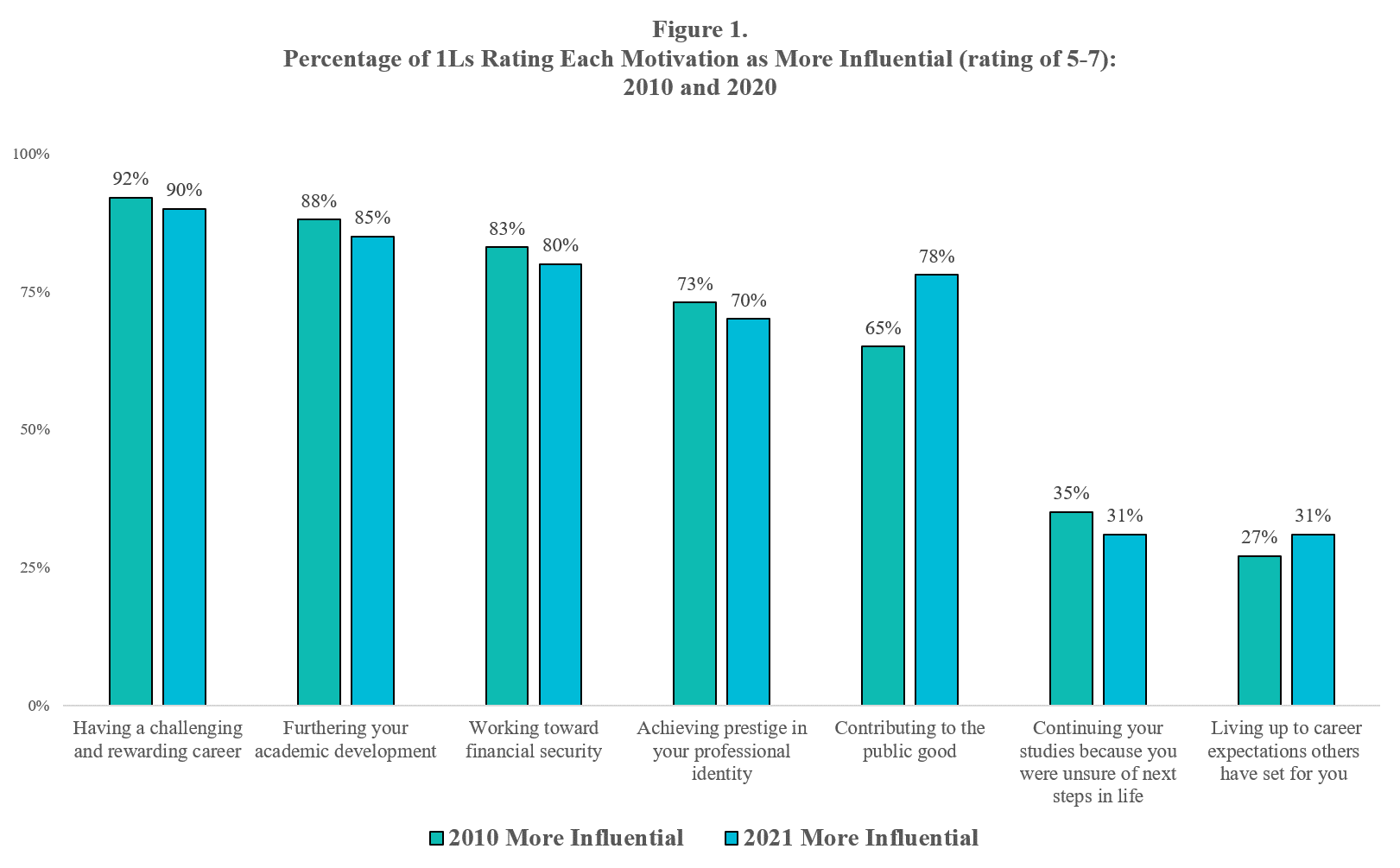
In a subsequent paper we began exploring that connection between motivations and aspirations using the same 2010 data.[8] Our interest there is in the links among motivations, preferred area of legal specialization,[9] and working in the criminal justice system, especially those wanting to work in a prosecutor’s office (or alternatively, in a public defender’s office).[10]
Viewed through the lens of motivation, those students in the 2010 motivation subset interested in criminal law saw contributing to the public good as a more influential motivation than did their peers interested in some other area of legal specialty. Their non-criminal law peers saw working toward financial security financial security as more influential.
Revealing a sharper contrast are the students interested in corporate and securities as their area of legal specialty. They are, in a sense, mirror opposites of the criminal law students in being driven much less by the public good, driven much more by financial security, and somewhat more by prestige. Only 39% of those interested in corporate/securities see public good as more influential compared to 72% for those interested in criminal law. The two groups of students clearly value different things and have different aspirations.
Having worked with the 2010 data and wanting something more contemporaneous, we asked the LSSSE administrators if they could add those seven motivation questions to the 2021 survey, and they generously did so. Those seven questions were asked to a subset of the 2021 survey participants (2,930 respondents, 15 law schools).
The 2010 data, while important in and of themselves, are just a snapshot in time. In wanting the 2021 data the key question for us is one about stability v. change. Are there any noticeable changes in student motivations, the interactions among motivations, and their connections to student aspirations? If so, what might help explain any change. The general patterns over time in the LSSSE data for job expectations would suggest relative stability rather than change.[11] Events in the broader societal environment since 2010 might suggest otherwise.[12] Our initial thought is the null hypothesis of no real change in motivations, which while generally the case isn’t in one important way. That exception involves the motivation of contributing to the public good.
Not only about the 2010 respondents, Figure 1 also presents a simple comparison of responses to the seven motivation questions in 2010 and in 2021 by 1L students.[13] The bars represent the percentage who reported that a motivation was more influential for them (a rating of 5, 6, or 7 on the seven-point scale). At first glance one sees a relatively stable pattern between 2010 and 2021, with small decreases in the degree of influence. The intrinsic motivations of a challenging career and academic development remain the most intense motivations followed by financial security.
One thing, however, stands out in an otherwise expected pattern of relative stability. Public good – an extrinsic motivation that is of particular interest to us – disturbs that pattern. Rather than the very slight decrease for the substantive motivations (all aside from “unsure of next steps” and “others’ expectations”), its influence is more important in 2021. Its influence became more important than prestige and close to that for financial security.
Digging a bit deeper into the data, we found that this increase does not appear to be just a matter of some general increase in the importance of public good. Instead, it is a matter of the intensity of the influence, and this is the most interesting finding. Again, the percentages in Figure 1 includes those giving a rating 5, 6, or 7. If we break that figure down, we see that the percentages for ratings 5 and 6 are essentially identical for the two years. For 2010, rating 5 = 17% and for 2021, rating 5 =17%. For 2010, rating 6= 17% and for 2021, it is 16%. For the highest, most intense rating we find 32% in 2010 and 45% in 2021. There is no comparable increase in intensity for the other substantive motivations (the greatest was for financial security, from 43% to 46%).
While our analyses looking at the characteristics of the students and schools involved in the two surveys are continuing, there are two matters worth noting concerning the public good, change, and intensity. Although quite different, both are instructive. The first involves gender. Female respondents rate the public good as more influential than their male counterparts in both surveys. For both groups, however, intensity increased as reflected in the percentage rating it at the highest ranking. In 2010, 37% of female respondents rated public good as very influential, while 23% of males did. In 2021, the percentages were 49% and 30%, respectively.
The second involves a very different way of looking at change and intensity – comparing students in particular schools rather than students in general. Two schools appeared in each motivation subset, allowing us to at least explore this. Because of the way in which LSSSE prepared the two data sets for us (using a unique code for each participating school that does not allow us to identify the school), we were able to find two schools appearing in 2010 and in 2021. For one of the schools the percentages of responding students rating public good at the highest level in each year are 25% and 41%, respectively. For the other school the comparable percentages are 20% in 2010 and 34% in 2021. Important here, as with gender, is not the exact percentages themselves (although those figures are not, of course, unimportant), but the idea of change in intensity even if the starting points were different. In short, something appears to be going on regarding student motivations.
Our comparative findings concerning change, though quite preliminary at this point, reinforce the importance of motivation for the study of legal education and the legal profession. An influx of students highly motivated by contributing to the public good has implications for both. It may shift the dynamics of the legal employment and increase the pool of graduates who aspire to much needed public service careers. At the same time, it means that law schools will need to provide the educational opportunities and support for those students to succeed, something not always the case. This could include working more closely with public service employers to provide needed opportunities and support.
___
[1] Stephen Daniels & Shih-Chun Chien, “Beyond Enrollment: Why Motivations Matter to the Study of Legal Education and the Legal Profession,” Guest Post, LSSSE Blog, September 24, 2020, ), https://lssse.indiana.edu/blog/guest-post-beyond-enrollment-why-motivations-matter/.
[2] Stephanie Francis Ward, “The ‘Trump Bump’ for Law School Applicants is Real and Significant, Study Says,” ABA Journal, February 22, 2018, https://www.abajournal.com/news/article/the_trump_bump_for_law_school_applicants_is_real_and_significant_survey_say; Karen Sloan, “Forget the ‘Trump Bump:’ First-Year Law School Enrollment Dipped in 2019,” December 12, 2019, Law.Com, https://www.law.com/2019/12/12/forget-the-trump-bump-law-school-enrollment-dipped-a-bit-in-2019/.
[3] Louis Toepfer, “Introduction,” in Seymour Warkov and Joseph Zelan, Lawyers in the Making (1965); at xv.
[4] Supra note 1 at 2.
[5] Id at 4.
[6] Id at 5.
[7] See supra note 1 at 6.
[8] Shih-Chun Chien & Stephen Daniels, “Who Wants to be a Prosecutor? and Why Care? Law Students’ Career Aspirations and Reform Prosecutors’ Goals,” Howard Law Journal (forthcoming 2022), using 2010 data to explore connections among motivations, preferred area of legal specialization, and preferred work setting upon graduation.
[9] The 2010 LSSSE survey asked students to choose from a list of 26 areas of legal specialization for their preferred area of specialization upon graduation.
[10] The analysis includes the issues of diversity and gender. One interesting finding is that African-American males interested in criminal law are more likely to eschew work as a prosecutor or as a public defender in favor of private practice. AAPI students are the least likely cohort to choose criminal law as their area of specialization.
[11] The Changing Landscape of Legal Education: A 15-Year LSSSE Retrospective (2020) at 9, https://lssse.indiana.edu/wp-content/uploads/2015/12/LSSSE_Annual-Report_Winter2020_Final-2.pdf.
[12] We are particularly interested in whether the rise and proliferation of progressive prosecutors and other recent civil justice reform/Black Lives Matter-type movements and anti-Asian hate crimes affect law students’ motivations and career aspirations.
[13] Our earlier blog reported on 1Ls who rated each motivation in 2010 at 6-7 (the two highest ranks). Here Figure1 reports on respondents who rated each motivation at 5-7. This is consistent with the approach we used in supra note 9. It also allows us to accentuate the changing intensity for motivations.



